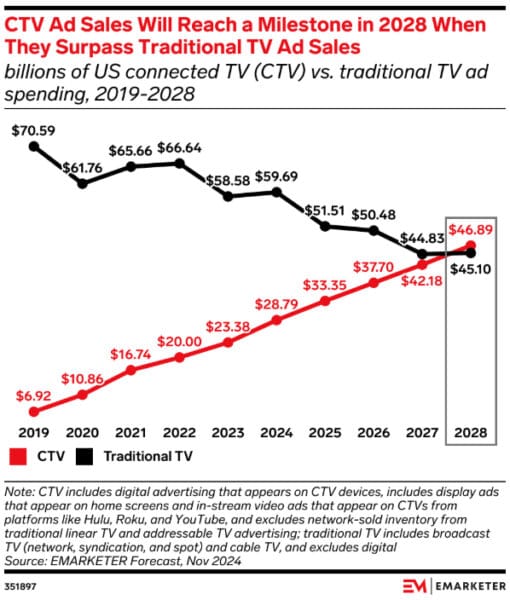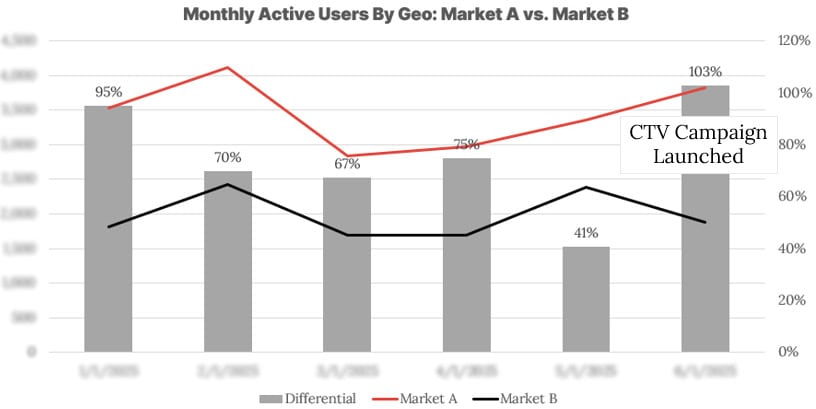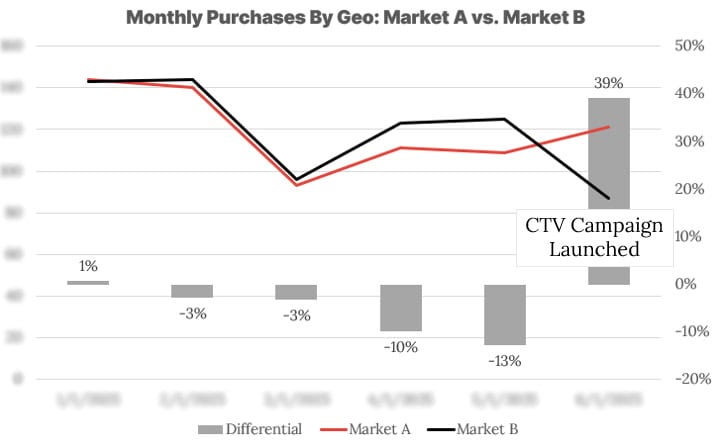
Most brands we speak to want to diversify their ad budget beyond Google and Meta, and the ad channel that keeps coming up is connected TV (CTV). This refers to ad delivery on internet-connected devices, such as smart TVs, streaming devices, and gaming consoles.
Recently, we launched and managed a CTV campaign for a consumer brand that led to double-digit growth in traffic and purchases in the regions where the campaign ran. More on this below.
What Makes CTV Ads Unique
Here are a few considerations for the CTV channel that make it unique:

CTV Ad Creative
Your videos must be 15 or 30 seconds. In most cases, the ad format is non-clickable and non-skippable, enabling richer storytelling than paid social content.
Consider the CTV viewing experience when producing your videos. Screen sizes are larger, so repurposing paid social content is not always effective if it’s filmed with lower-resolution cameras and optimized for vertical placements. Also, if someone is watching a show with high production quality, it could be an odd juxtaposition if you run an ad with low production value.
Lastly, we recommend dialogue or using a voiceover to reach people who aren’t watching the screen.
CTV Audience Targeting
Audience targeting on CTV is programmatic, meaning you can’t target specific channels or programs. Rather, you choose an audience, meaning your ad(s) will run wherever that audience is consuming content on CTV. And the audience is a household rather than a unique person.
Most CTV platforms will allow you to build an audience a few ways:
- First-party data: Upload emails or place a pixel on your site to build remarketing or exclusion audiences.
- Interest-based: Target affinity and behavioral audience segments from third parties like LiveRamp, Experian, etc.
- AI: Some platforms have tech that leverages AI to scan your site and make audience recommendations.
You’re able to target specific geographies and get as granular as a zip code, which is helpful for measuring performance.
CTV Ad Performance
There may be a lag of up to 24 hours for performance data from your CTV campaign to appear in the platform’s ad dashboard.
Also, some platforms will display your average sales cycle. This metric indicates the average time between when someone sees your CTV ad and when they convert on your site. This is helpful to understand user behavior compared to other ad channels that may be more direct-response oriented.
6 Ways To Measure CTV Campaigns
We recommend tracking several data points to help paint a picture of your campaign’s performance.
1. In-Platform Data
Platforms attribute actions to CTV ads using IP addresses. For instance, if you view a CTV ad at home and then visit an advertiser’s website on your mobile device or computer on the same Wi-Fi network, then that behavior can be attributed to the CTV ad.
The downside of this method is messy attribution. In the above scenario, if that person clicked on a Meta or Google ad and then happened to see the CTV ad before visiting your site and converting, it’s unclear how much influence the CTV ad had. Or perhaps another person in the household saw the CTV ad and it’s not the same person who visited the website and converted.
Some platforms offer built-in holdout audiences to track incremental conversions.
2. GA4 Website Data
Some platforms have an integration with GA4 so that traffic attributed to your CTV campaigns is designated with certain UTM parameters. This is helpful for tracking purposes and comparing performance across ad channels.
3. Geo Holdout Test
An effective way for brands to test CTV is by targeting a specific city, DMA, or state. If you isolate delivery of your ads to that geo, then you can see if there’s any lift during the flight compared to the prior period (e.g. month, year, etc.). This doesn’t take into account seasonality, though.
Ideally, you can identify two geos that are highly correlated relative to traffic and conversions, and then choose one geo for your CTV test and treat the other geo as the control.
4. CTV Creative Options
Use a vanity URL or promote a discount code in the creative that you don’t use anywhere else. That way, any traffic or purchases attributed to the URL or discount code can be traced back to the campaign. Some advertisers include QR codes in the creative, but we advise against that due to lower redemption rates.
5. Post-Conversion Survey
If you ask website users how they heard about you after they convert, include CTV as an option. If you know what percentage of total users fill out the survey, then you can extrapolate the results to measure the impact.
6. Halo EffecT On Other Channels
No ad platform performs in a vacuum, and a typical buyer’s journey may include exposure to ads from several channels.
With that in mind, analyze the performance of other ad channels concurrently with your CTV campaign. You may observe improved paid search metrics like impression volume, CTR, and conversion rate.
How We Built A Successful CTV Campaign
In a recent CTV campaign, we produced several videos for a client using footage from a production with a celebrity endorser.
- One video focused on the celebrity’s preferred products. The other listed various health benefits of the products.
- We added a persistent logo and URL in the creative for enhanced ad recall.
- We included a video & audio CTA at the end of each ad.
We adopted a geo-targeted strategy, selecting two U.S. markets with a ~0.9 correlation coefficient in monthly traffic and purchases over nine months, designating Market A as treatment and Market B as control.
GA4 data showed an immediate uptick upon campaign launch:
- In the 4 months before the campaign launched, website traffic from Market A was ~62% higher than Market B. In the month the campaign launched, website traffic from Market A grew to +103% vs. Market B.
- In the 4 months before the campaign launched, purchases from Market A were ~7% lower than Market B. In the month the campaign launched, purchases from Market A were +39% vs. Market B.


In addition, we tracked data from the post-purchase survey and from UTM parameters in GA4. The CPMs on the campaigns were ~$22, which were comparable to conversion campaigns on Meta.
Want to discuss your next CTV campaign? Have questions on whether CTV is the right channel for you? Reach out to us at [email protected] for a free consultation.



